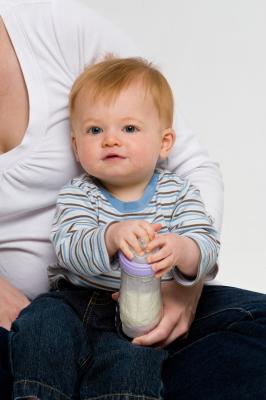A milk allergy is the most common food allergy for kids, but most of them outgrow it by the time they are 2 or 3 years old. A milk allergy is different from being lactose intolerant, but many people confuse the two. With lactose intolerance, you have a reaction to the sugar lactose. With a milk allergy, you react to the proteins in milk.
Allergy Versus Intolerance
An allergy to milk causes symptoms such as hives, vomiting and difficulty breathing after consuming milk or milk products. Lactose intolerance can make you feel bloated, nauseous and gassy or cause diarrhea. However, some people with a milk allergy can also have stomach pains and feel bloated, which contributes to the confusion. An allergy involves the immune system, and lactose intolerance involves the digestive system.
Symptoms in a Baby
If your formula-fed baby is unusually fussy much of the time, she may have a milk allergy. Cow’s milk is the basis for most commercial formulas. If your baby is allergic to milk, her body is fighting the milk protein, which causes an upset stomach and irritability. Other symptoms she may have are loose stools, vomiting, colic and skin rashes. She may also refuse to eat.
Changing Formulas
Take your baby to the doctor for testing if you suspect a milk allergy. You may have to give your baby a different type of formula, such as a soy-based one. If soy isn’t any better, your baby may need a hypoallergenic formula.
Breastfed Babies
Some breastfed babies can develop a milk allergy, too, but the risk is lower. If your baby is allergic and you breast-feed, restrict the dairy products you eat. Supplement with other sources of calcium, such as broccoli, spinach, kale, oranges, tofu, peanuts, peas, black beans, salmon, sardines, sesame seeds, blackstrap molasses, corn tortillas, brown sugar and almonds.
Older Kids
While most kids outgrow a milk allergy by the time they are 5 years old, some kids never outgrow it and have to watch what they eat. Otherwise, they can become severely ill. The worst reaction your child can get is anaphylaxis, a swelling of the mouth, throat and airways, making him unable to breathe. With anaphylaxis, the blood pressure can drop, which can make your child pass out. More common reactions to a milk allergy are hives, eczema, swelling around the mouth, cramps, diarrhea, vomiting, runny nose, watery and itchy eyes and sneezing.
What Not to Eat
Read food labels, and teach your child not to eat anything she is unsure of. Don’t give her foods that list casein as an ingredient. Don’t give her cheese, yogurt, pudding, butter, margarine, non-dairy creamers and whey. It’s best to work with a dietitian to determine a healthy diet for your child to make sure she gets all the vitamins and nutrients she needs in addition to avoiding milk and milk products. Vegan foods, for example, do not contain milk.





